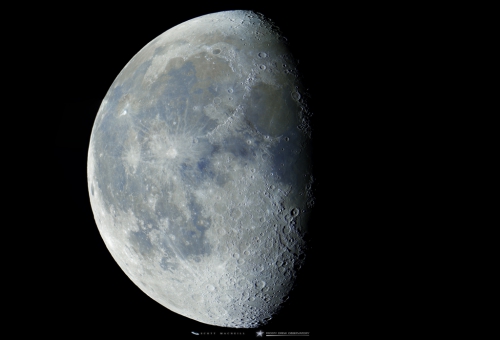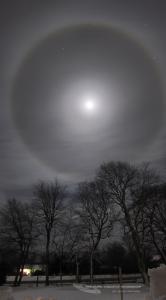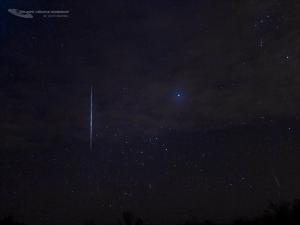
Stargazing Nights
- Where:
- Frosty Drew Observatory
- When:
- Friday December 8, 2017 - CLOSED
- Cost:
- $1 Suggested Donation per Person
Tonight is Stargazing Night at Frosty Drew Observatory and the coming snow will bring full cloud cover to our skies. Unfortunately, this will keep our telescopes closed tonight. We also have a 68% waning gibbous Moon rise at 10:16 p.m. tonight, which would have offered us a nice bout of dark skies before the Moon took over. If you are in the path of the coming snow storm, see if you can catch a view of the Moon after 11:00 p.m. tonight. If clouds are thin enough over your location, you just may catch sight of a fantastic 22° lunar halo. Frosty Drew Observatory opens again on Wednesday, December 13th at 6:30 p.m. for the fabulous Geminid Meteor Shower. Clouds begone!
-------------------
Weekly Happenings
Scott MacNeill
Being that the Winter Solstice is about two weeks out, lunar halos are becoming more prevalent. A 22° halo forms around the Moon (and the Sun) when hexagon shaped ice crystals form and orientate in the upper troposphere. These crystals refract moonlight (sunlight) deflecting it twice (once when entering the crystal, and again when exiting). Due to the orientation of the ice crystal, the angle that light deflects is 22° to 50°. Crystals orientated where the angle of deflection is equal when light enters the crystal and exits (minimum deviation angle) will deflect the light at an angle of 22°. This results in a halo around the Moon with a 22° radius that is unique to each observer. Being that the wavelengths of light have an impact on the how the light refracts, the blue wavelengths (shorter wavelengths) will take slightly longer to refract through the crystal, causing an increase in deflection angle by a little less than 1° when compared to the red wavelengths (longer wavelengths). This produces a red inner edge of the halo with the outer edge tapering off to blue. Inside the halo, the sky will appear darker than the outside of the halo, appearing like a hole in the sky. All that aside, you need cold air in the upper troposphere with a lot of moisture present for a halo to form. A coming snowstorm sets up optimal atmospheric conditions for a 22° halo. All that’s needed after that is the Moon (or Sun) and an observer.
The Geminid Meteor Shower is now underway! Starting yesterday (December 7) we will see heightened meteor activity with each passing night as we approach the peak night on Wednesday, December 13th. During the peak the Geminids can bring upwards of 120 meteors per hour if viewing conditions are optimal, with the potential for higher frequencies. Unlike most meteor showers, which originate from comets, the Geminids are a result of the asteroid 3200 Phaethon, which has a highly eccentric orbit, passing closer to the Sun than any other named asteroid during its perihelion (closest approach to the Sun). Phaethon’s highly eccentric orbit and unusual composition have raised questions about the origin of the asteroid with it often referred to as a rock comet. Phaethon also passes relatively close to Earth, with a close pass happening on December 16, 2017 at a distance of 6.4 million miles. This will be the closest pass of Phaethon to Earth for the next 76 years. If there was one meteor shower to make an effort to see, it’s the Geminds. The shower starts early (around 9:00 p.m.) and continues until dawn. Frosty Drew Observatory will open on Wednesday, December 13th at 6:30 p.m. (weather permitting) to celebrate the awesome meteor display. Viewing the shower will be easy, but cold! Lay on your back so you are facing the top of the sky and orientate yourself so your feet are to the southwest. It will be cold in New England on the night of the Geminid peak so full winter attire will be required. Read about the Frosty Drew Observatory Geminid event and then catch up on how to dress for all-night winter stargazing.
We have had some excellent evening passes of the International Space Station (ISS) this December, and the passes continue this week. If you have clear skies tomorrow night, step outside at 4:57 p.m. and catch the ISS in the NNW, rising to about 14° heading towards the north. Best passes this week will be Sunday at 5:41 p.m. in the NNW, rising to 20° heading towards the NNE; Tuesday at 5:33 p.m. in the NW, rising to 32° heading towards the NE; Wednesday (Geminid Meteor Shower!) at 6:17 p.m. in the WNW, rising to 55° heading west; Thursday at 5:24 p.m. in the NW, rising to 63° heading towards ESE. These times are applicable for most of Southern New England. Visit NASAs Spot the Station for pass times over your location. Make a point at seeing the ISS this week and tip your hat to humanities only continuously inhabited space destination.
-Scott



